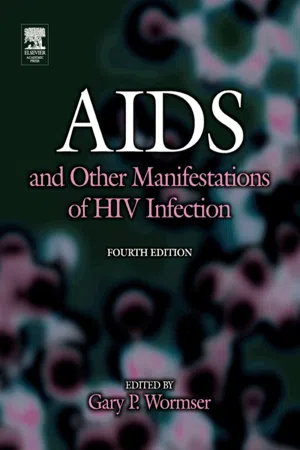
- 1,000 pages
- English
- ePUB (mobile friendly)
- Available on iOS & Android
AIDS and Other Manifestations of HIV Infection
About this book
Extensively revised and updated, the new edition of AIDS and Other Manifestations of HIV Infection is an essential reference resource providing a comprehensive overview of the biological properties of this etiologic viral agent, its clinicopathological manifestations, the epidemiology of its infection, and present and future therapeutic options.- Expanded section on clinical manifestations includes new chapters on cardiovascular, renal and dermatologic manifestations of HIV infection- Additional chapters on molecular diagnostic techniques, the role of host genetic variation in HIV infection and its manifestations, the discovery and development of new HIV medicines, analysis of HIV dynamics using mathematical models, toxicities of antiretroviral therapy, HIV drug susceptibility testing, practical therapeutics and the global impact of HIV and AIDS
Frequently asked questions
- Essential is ideal for learners and professionals who enjoy exploring a wide range of subjects. Access the Essential Library with 800,000+ trusted titles and best-sellers across business, personal growth, and the humanities. Includes unlimited reading time and Standard Read Aloud voice.
- Complete: Perfect for advanced learners and researchers needing full, unrestricted access. Unlock 1.4M+ books across hundreds of subjects, including academic and specialized titles. The Complete Plan also includes advanced features like Premium Read Aloud and Research Assistant.
Please note we cannot support devices running on iOS 13 and Android 7 or earlier. Learn more about using the app.
Information
BACKGROUND AND CONTEXT
Table of contents
- Cover image
- Title page
- Table of Contents
- Copyright
- List of Contributors
- Preface
- Acknowledgments
- DEDICATION
- Chapter 1: The Epidemiology of HIV and AIDS
- Chapter 2: Epidemiology of Pediatric HIV Infection
- Chapter 3: The Genetic Diversity and Global Molecular Epidemiology of HIV
- Chapter 4: Introduction to Retroviruses
- Chapter 5: The Neuropathogenesis of HIV-1 Infection
- Chapter 6: Viral Cofactors in the Immune Pathogenesis and Clinical Manifestations of HIV Infection
- Chapter 7: Virologic and Biologic Features of Human Immunodeficiency Virus Type 2 (HIV-2)
- Chapter 8: Laboratory Detection of Human Retroviral Infection
- Chapter 9: Molecular Diagnostic Techniques and Other Tests for Direct Detection of HIV
- Chapter 10: Simian Retroviruses
- Chapter 11: Immunodeficiency in HIV-1 Infection
- Chapter 12: The Role of Host Genetic Variation in HIV Infection and its Manifestations
- Chapter 13: Care of the Adult Patient with HIV Infection
- Chapter 14: HIV Disease in Women
- Chapter 15: HIV Infection in Children
- Chapter 16: Pulmonary Complications of HIV Infection
- Chapter 17: Mycobacterial Disease in Patients with HIV Infection
- Chapter 18: Neurologic Complications of HIV and AIDS
- Chapter 19: AIDS Psychiatry: Psychiatric and Palliative Care, and Pain Management
- Chapter 20: The Gastrointestinal and Hepatobiliary Systems in HIV Infection
- Chapter 21: Neoplastic Complications of HIV Infection
- Chapter 22: Hematologic Manifestations of HIV Infection
- Chapter 23: Cardiac Manifestations in Human Immunodeficiency Virus Infection
- Chapter 24: Renal Manifestations of HIV Infection
- Chapter 25: Skin Manifestations of HIV Infection
- Chapter 26: Ophthalmologic Aspects of HIV Infection
- Chapter 27: General Pathology of HIV Infection
- Chapter 28: Neuropathology of AIDS
- Chapter 29: Infection Control Considerations to Prevent HIV Transmission in Healthcare Settings
- Chapter 30: HIV Era Occupational Exposures and Risks
- Chapter 31: Antiretroviral Chemotherapy
- Chapter 32: Discovery and Development of New HIV Medicines
- Chapter 33: Toxicities of Antiretroviral Therapy
- Chapter 34: HIV Drug Susceptibility Testing
- Chapter 35: The Analysis of HIV Dynamics Using Mathematical Models
- Chapter 36: Practical Therapeutics
- Chapter 37: Immune-based Therapies for HIV Infection
- Chapter 38: Immunizations, Vaccine-Preventable Diseases, and HIV Infection
- Chapter 39: Progress in the Development and Testing of HIV Vaccines
- Chapter 40: The Public Health Response to the HIV Epidemic in the U.S.
- Chapter 41: The Global Impact of HIV and AIDS
- Chapter 42: Nursing Perspectives in the Care of Persons with HIV Infection
- Chapter 43: Ethical Challenges of the Global AIDS Epidemic
- Subject Index